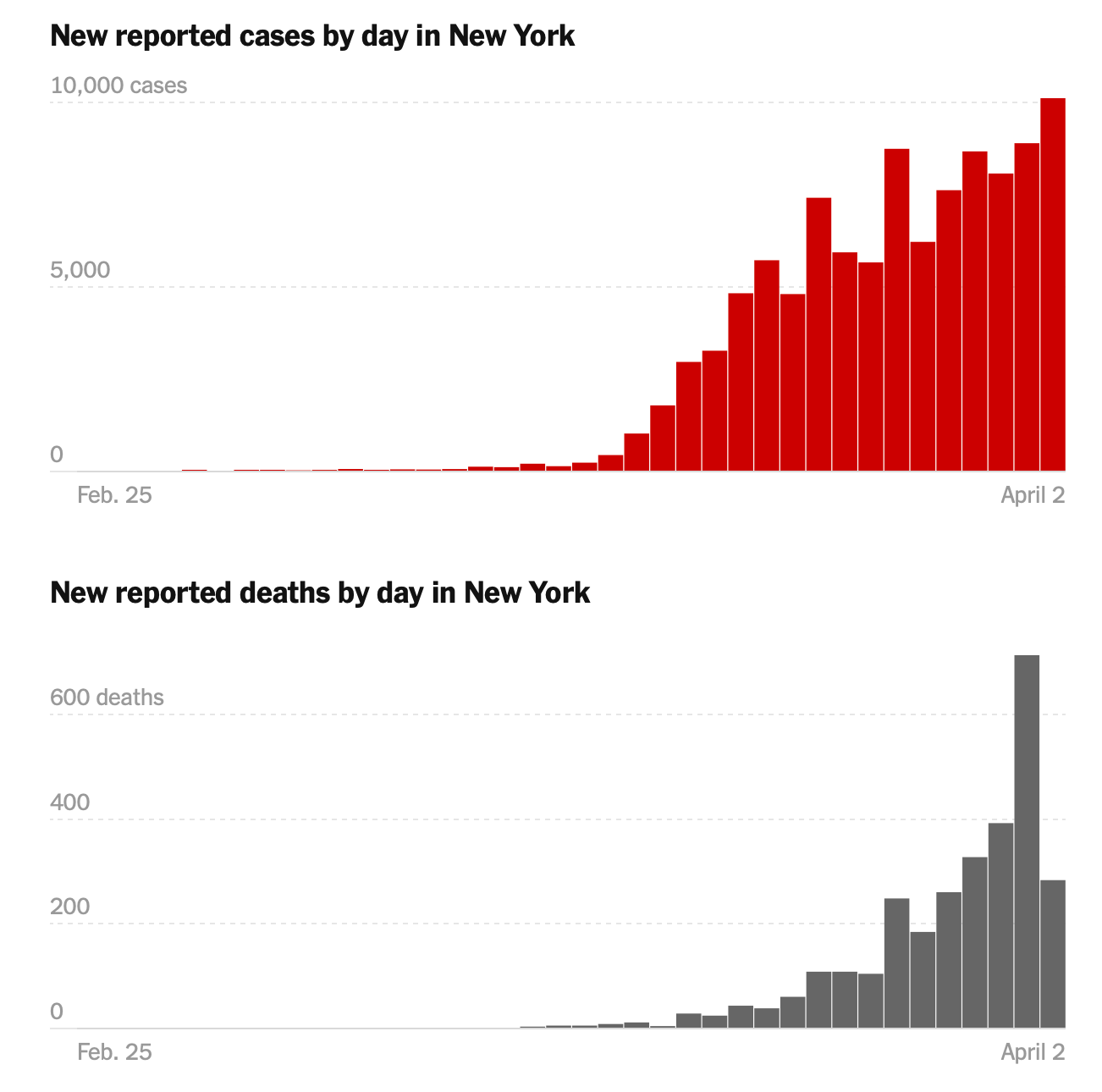What’s on my mind?
Home-schooling. Our online learning is sort of a joke. The teachers are just barely sending over what’s needed. We’re trying our best, but it’s hard. I can only imagine it will only get better as the teachers and staff figure it out.
Speaking of, this is a GREAT read about how higher ed (mostly colleges) will adapt post-COVID and how they and tech will merge. It will be fascinating to watch over the next 5 years.
Getting Out. Sasha and I are very similar. We both love to get out of the house and be active. If we don’t leave the house and do a walk or run, we’re crabby during the day and don’t sleep as well at night. We’re starting to combat this problem by taking long walks around 5-6pm, before dinner. Yesterday we took a nice 50 minute bike ride down the road. We’re both a bit nicer when we return.
Finally, NYC. The situation there seems exceptionally dire. There was an Amber Alert-like message sent to everyone in NYC asking if they know of any licensed healthcare workers.
A big thank you for the bday wishes – this year it’s all about fighting #COVID19 and healthcare workers are on the front lines.
So I’m asking anyone with a few extra $$ to donate to @NYCHealthSystem – below is a link to my fundraiser. 🙏🏽https://t.co/41eKXRcs4f pic.twitter.com/bGnzMAlzW2
— errol barnett (@errolbarnett) April 3, 2020
and still the subways are packed with people…

The field hospital in New York’s Central Park is already at half capacity on its third day treating Covid-19 patients, according to the director of the facility https://t.co/iznk8Jb0G9
— CNN (@CNN) April 4, 2020
Not surprisingly, the cases are still climbing in NYC:

Other Stuff
For those of you who are Sandra Bulluck fans or fans of While You Were Sleeping will need to read the following (thx Lizzie):
delete everything on the internet except for this pic.twitter.com/XgQpsOMfq1
— Erin 🏃🏻♀️🦠 Ryan (@morninggloria) April 2, 2020
Happy birthday to my favorite chef, @Chris_Meloni.
— Michael Ian Black (@michaelianblack) April 3, 2020
Cases
- World: Cases 1,139,207. Deaths: 60,874 (up 7,901 – a daily increase of 80%)
- USA: Cases 278,537. Deaths: 7,163 (up 1252 – a daily increase of 62%)
- Marin: 131 cases (up 13), 6 deaths

This is possibly the most accurate gif I’ve ever seen. pic.twitter.com/mbH9lvQ641
— Jon Green (@jon_m_green) March 30, 2020







![Reblog this post [with Zemanta]](http://img.zemanta.com/reblog_e.png?x-id=61cd260d-d4e3-4ca1-bb8b-aac5f35847af)


![Reblog this post [with Zemanta]](http://img.zemanta.com/reblog_c.png?x-id=44e903c1-822c-422a-be14-28ce4dd6a81a)



 In four seasons as a full-time starter Santana went 70-32, winning two ERA titles and three strikeout crowns while capturing a pair of Cy Young awards and deserving a third. It was an amazing metamorphosis. At 21 years old Santana was a little-known Rule 5 pick who showed some promise, at 23 years old he was an ace-in-waiting who dominated from the bullpen or rotation, and at 25 years old he was the best pitcher in baseball. Three years later he’d be the best pitcher in baseball and all of us in MN were pretty damn happy.
In four seasons as a full-time starter Santana went 70-32, winning two ERA titles and three strikeout crowns while capturing a pair of Cy Young awards and deserving a third. It was an amazing metamorphosis. At 21 years old Santana was a little-known Rule 5 pick who showed some promise, at 23 years old he was an ace-in-waiting who dominated from the bullpen or rotation, and at 25 years old he was the best pitcher in baseball. Three years later he’d be the best pitcher in baseball and all of us in MN were pretty damn happy.
 This past weekend i checked out the uber-indie flick Mutual Appreciation. At first, i was completely bored, but then i began to notice that the film has some real brilliance.
This past weekend i checked out the uber-indie flick Mutual Appreciation. At first, i was completely bored, but then i began to notice that the film has some real brilliance. There is a strange series of events that occur when Alan stops by a party well after it has finished and hangs out with 3 drunk women. Normally this would result is a bizarre series of events that’s pretty funny but instead this film portrays how current gender relations have shifted and in today’s post-feminist era women end up completely dominating tentative males
There is a strange series of events that occur when Alan stops by a party well after it has finished and hangs out with 3 drunk women. Normally this would result is a bizarre series of events that’s pretty funny but instead this film portrays how current gender relations have shifted and in today’s post-feminist era women end up completely dominating tentative males